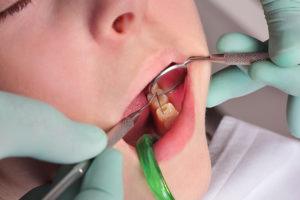
No one wants to visit the dentist and hear “you have a cavity.” But, tooth decay is one of the most common problems diagnosed in the dental chair. Luckily, cavities are preventable. The best thing you can do is learn about tooth decay to reduce the risk of cavities in the future.
While many people assume that they have common knowledge about cavity prevention and treatment, there are many myths floating around about cavities. At myDental, we want to help you maintain a healthy, beautiful smile. Today, we’re sharing a few myths and facts about cavities, so you know the best ways to care for your teeth:
Myth: Cavities are Caused By Sugar
Fact: Sugar itself doesn’t cause cavities. Instead, cavities form when a combination of acid and bacteria is present in your mouth. When sugar is eaten, the carbohydrates feed the bacteria that trigger conditions for cavity development. You don’t have to eat something sweet to get cavities. The sugar in other starchy foods can also lead to these conditions, such as bread, rice, potatoes, and more.
Myth: You’ll Know When You Have a Cavity
Fact: Most patients don’t experience symptoms in the early stage of cavity development. Mild tooth decay doesn’t cause pain or sensitivity. If the tooth decay is on the surface of the tooth, then you might be unaware of the problem. Symptoms start showing when the decay reaches the nerve of the tooth, resulting in more expensive and complicated dental treatments. Regular dental exams are important to identify tooth decay in the early stages, giving you the option for treatment before you notice the symptoms.
Myth: Discoloration on the Tooth is a Cavity
Fact: Just because you have a spot of discoloration, doesn’t mean that you have a cavity that needs to be treated. Sometimes, the decay process starts and then stops… as a result, the enamel on the tooth hardens up again. Or, discoloration could be due to staining from foods that you eat or medications that are used. The discoloration might stay, but it doesn’t always mean that the tooth needs a filling. If you notice discoloration, then it is important to talk to your dentist to see if treatment is required.
Myth: Don’t Worry about Cavities in Baby Teeth
Fact: When cavities are present and untreated in baby teeth, it could lead to the development of infection. In severe situations, these dental problems could impact the growth and development of permanent teeth. Good oral care practices are important at every stage in life. Teaching children to brush and floss in the early years is an important step to promote healthy teeth in adulthood. Schedule regular exams when your child’s teeth start popping through the gums.
Cavity Prevention for Every Age
The best thing you can do to prevent cavities is to maintain consistency with regular brushing and flossing habits. Brushing at least twice a day with fluoride toothpaste is an effective measure to remove bacteria from the surface of the teeth, helping to reduce the risk of tooth decay. Flossing once a day should also be a part of your routine.
If you would like personal recommendations about your dental health, then talk to our team at myDental to learn more about other treatments to protect your smile. Visit one of our locations for an exam: Tech Ridge and Norwood Park.